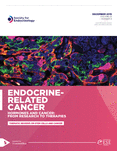Identifying and targeting tumor-initiating cells in the treatment of breast cancer
- 1Baylor College of Medicine, Lester and Sue Smith Breast Center, Houston, Texas, USA
2Departments of Molecular and Cellular Biology
3Radiology, Baylor College of Medicine, One Baylor Plaza, BCM600, Room N1210, Houston, Texas 77030, USA
- Correspondence should be addressed to M T Lewis; Email: mtlewis{at}bcm.edu
Abstract
Breast cancer is the most common cancer in women (excluding skin cancer), and it is the second leading cause of cancer-related deaths. Although conventional and targeted therapies have improved survival rates, there are still considerable challenges in treating breast cancer, including treatment resistance, disease recurrence, and metastasis. Treatment resistance can be either de novo – because of traits that tumor cells possess before treatment – or acquired – because of traits that tumor cells gain in response to treatment. A recently proposed mechanism of de novo resistance invokes the existence of a specialized subset of cancer cells defined as tumor-initiating cells (TICs), or cancer stem cells (CSCs). TICs have the capacity to self-renew and to generate new tumors that consist entirely of clonally derived cell types present in the parental tumor. There are data to suggest that TICs are resistant to many conventional cancer therapies and that they can survive treatment in spite of dramatic shrinkage of the tumor. Residual TICs can then eventually regrow, which results in disease relapse. It has also been hypothesized that TIC may be responsible for metastatic disease. If these hypotheses are correct, targeting TICs may be imperative for achieving a cure. In the present review, we discuss evidence for breast TICs and their apparent resistance to conventional chemotherapy and radiotherapy as well as to various targeted therapies. We also address the potential impact of breast TIC plasticity and metastatic potential on therapeutic strategies. Finally, we describe several genes and signaling pathways that appear to be important for TIC function and may represent promising therapeutic targets.
- Revision received 30 March 2015
- Accepted 7 April 2015
- Made available online as an Accepted Preprint 15 April 2015
- © 2015 Society for Endocrinology















